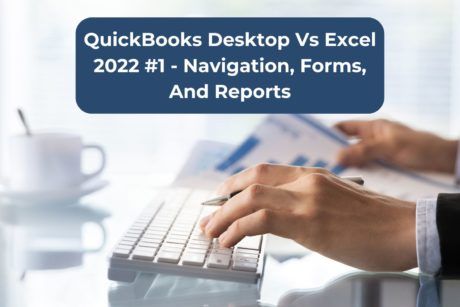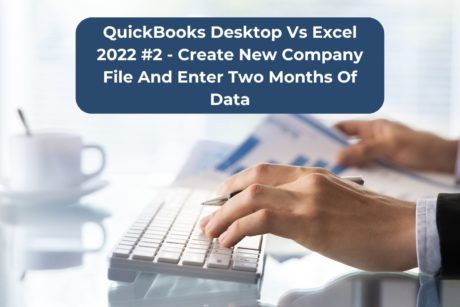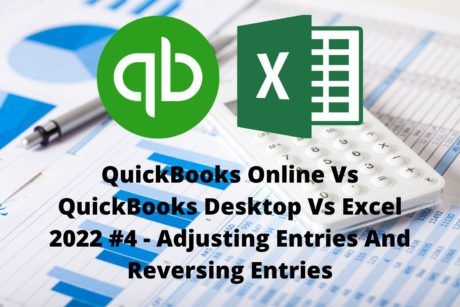Learn the process of entering period-end adjusting entries using QuickBooks Desktop and Excel. Read more.
Robert (Bob) Steele CPA, CGMA, M.S. Tax, CPI
Access all courses in our library for only $9/month with All Access Pass
Get Started with All Access PassBuy Only This CourseAbout This Course
Who this course is for:
- Accountants
- Bookkeepers
- Business owners
What you’ll learn:
- The process of adjusting entries and how and why adjusting entries are separate from the general data input process
- How to enter reversing entries
Requirements:
- No prior knowledge is required to take this course
Software version used in the course:
- QuickBooks Desktop 2022
This course will compare the process of entering period-end adjusting entries using QuickBooks Desktop and Excel. Because Excel is a much more transparent tool, it will provide us a much better understanding of the workings of QuickBooks.
QuickBooks Desktop components of the course
We will enter period-end, typically month or year-end, adjusting entries.
Learners will understand the process of adjusting entries and how and why adjusting entries are separate from the general data input process.
We will learn how to transition from the accounting data input to the adjusting process and back to data input for the following month as smoothly as possible.
Making the transitions between the accounting data input and adjusting entries smooth requires reversing entries.
We will discuss which entries should need reversing and why. Learners will understand how to enter reversing entries.
The course will also cover the generation of reports, using filtering options, to show the adjusting and reversing entries.
Excel components of the course
This course will focus on period-end adjusting entries, entries needed to report financial statements accurately on an accrual basis.
Learners will know how to navigate Microsoft Excel and use a well-designed accounting worksheet, complete with a general journal, trial balance, general ledger, subsidiary ledgers for accounts receivable, accounts payable, and inventory, financial statements, and much more.
Excel is an excellent tool to learn accounting because it is much more transparent than a database program, like accounting software. QuickBooks is a typical example of accounting software.
For most new steps in our accounting practice problem, you will have access to a downloadable Excel Workbook containing at least two tabs, one with the answer, the new tasks completed, the other starting where the prior presentation left off.
We will discuss adjusting entries, how to format an adjusting entry worksheet, and how the day-to-day accounting process and the period-end adjusting entries fit together.
Next, we will enter adjusting entries and reversing entries for accrued interest, the interest we have incurred but have not yet paid.
Then we will enter adjusting entries and reversing entries related to an invoice or sales transaction originally entered after the cutoff date, month-end, but for which the work was done before the cutoff date.
After that, we will enter adjusting entries for prepaid insurance, which leads to the next adjusting entry for depreciation.
Next, we will enter adjusting entries and reversing entries related to unearned revenue. The unearned revenue entry is different from many book problems but a standard method when using accounting software.
Then we will enter a transaction to break out the short-term and long-term portion of loans according to their related amortization tables.
Finally, we will take the adjusted trial balance, a trial balance constructed after entering the adjusting entries, and create financial statements.
Our Promise to You
By the end of this course, you will have learned how to adjust and reverse entries.
10 Day Money Back Guarantee. If you are unsatisfied for any reason, simply contact us and we’ll give you a full refund. No questions asked.
Get started today!
Course Curriculum
| Section 1 - QBD - Introduction | |||
| Documents To Download | 00:00:00 | ||
| 6010 Restore And Backup Data Files | 00:00:00 | ||
| 10120 Adjusting Entries And Reversing Entries Introduction | 00:00:00 | ||
| Section 2 - Excel - Adjusting Entries Introduction | |||
| Documents To Download | 00:00:00 | ||
| 10175 Adjust Worksheet For Adjusting Entries | 00:00:00 | ||
| Section 3 - QBD - Accrued Interest Adjusting And Reversing Entries | |||
| 10180 Adjusting Entry Accrued Interest | 00:00:00 | ||
| 10220 Reversing Entry Accrued Interest | 00:00:00 | ||
| Section 4 - Excel - Accrued Interest | |||
| 10180 Adjusting Entry Accrued Interest Part 1 | 00:00:00 | ||
| 10182 Adjusting Entry Accrued Interest Part 2 | 00:00:00 | ||
| 10220 Reversing Entry Accrued Interest | 00:00:00 | ||
| Section 5 - QBD - Accounts Receivable Or Revenue Adjusting And Reversing Entries | |||
| 10260 Adjusting Entry Accounts Receivable Sales | 00:00:00 | ||
| 10300 Reversing Entry Accounts Receivable Sales | 00:00:00 | ||
| Section 6 - Excel - Accounts Receivable Or Revenue | |||
| 10260 Adjusting Entry Accounts Receivable Sales | 00:00:00 | ||
| 10300 Reversing Entry Accounts Receivable Sales | 00:00:00 | ||
| Section 7 - QBD - Insurance Adjusting Entries | |||
| 10340 Adjusting Entry Prepaid Insurance | 00:00:00 | ||
| Section 8 - Excel - Prepaid Insurance | |||
| 10340 Adjusting Entry Prepaid Insurance | 00:00:00 | ||
| Section 9 - QBD - Depreciation Adjusting Entry | |||
| 10380 Adjusting Entry Depreciation | 00:00:00 | ||
| Section 10 - Excel - Depreciation | |||
| 10380 Adjusting Entry Depreciation | 00:00:00 | ||
| Section 11 - QBD - Unearned Revenue Adjusting And Reversing Entries | |||
| 10400 Adjusting Entry Unearned Revenue Customer Deposit | 00:00:00 | ||
| 10460 Reversing Entry Unearned Revenue Customer Deposit | 00:00:00 | ||
| Section 12 - Excel - Unearned Revenue | |||
| 10400 Adjusting Entry Unearned Revenue Customer Deposit | 00:00:00 | ||
| 10460 Reversing Entry Unearned Revenue Customer Deposit | 00:00:00 | ||
| Section 13 - QBD - Loan Short Term And Long Term Portion Adjusting And Reversing Entries | |||
| 10465 Adjusting Entry Loan Payable Short-Term And Long-Term Portions | 00:00:00 | ||
| 10467 Reversing Entry Loan Payable Short-Term And Long-Term Portions | 00:00:00 | ||
| Section 14 - Excel - Loans Short Term And Long Term Portion | |||
| 10465 Loan Payable Short-Term And Long-Term Portion | 00:00:00 | ||
| 10467 Reversing Entry Loan Payable Short-Term Long-Term Portion | 00:00:00 | ||
| Section 15 - QBD - Journal Reports | |||
| 10480 Adjusting Entry And Reversing Entry Journal Reports | 00:00:00 | ||
| Section 16 - Excel - Financial Statements | |||
| 10480 Financial Statements With Every Account | 00:00:00 | ||
| 10485 Balance Sheet Condensed Format | 00:00:00 | ||
| 10490 Income Statement Condensed Format | 00:00:00 | ||
About This Course
Who this course is for:
- Accountants
- Bookkeepers
- Business owners
What you’ll learn:
- The process of adjusting entries and how and why adjusting entries are separate from the general data input process
- How to enter reversing entries
Requirements:
- No prior knowledge is required to take this course
Software version used in the course:
- QuickBooks Desktop 2022
This course will compare the process of entering period-end adjusting entries using QuickBooks Desktop and Excel. Because Excel is a much more transparent tool, it will provide us a much better understanding of the workings of QuickBooks.
QuickBooks Desktop components of the course
We will enter period-end, typically month or year-end, adjusting entries.
Learners will understand the process of adjusting entries and how and why adjusting entries are separate from the general data input process.
We will learn how to transition from the accounting data input to the adjusting process and back to data input for the following month as smoothly as possible.
Making the transitions between the accounting data input and adjusting entries smooth requires reversing entries.
We will discuss which entries should need reversing and why. Learners will understand how to enter reversing entries.
The course will also cover the generation of reports, using filtering options, to show the adjusting and reversing entries.
Excel components of the course
This course will focus on period-end adjusting entries, entries needed to report financial statements accurately on an accrual basis.
Learners will know how to navigate Microsoft Excel and use a well-designed accounting worksheet, complete with a general journal, trial balance, general ledger, subsidiary ledgers for accounts receivable, accounts payable, and inventory, financial statements, and much more.
Excel is an excellent tool to learn accounting because it is much more transparent than a database program, like accounting software. QuickBooks is a typical example of accounting software.
For most new steps in our accounting practice problem, you will have access to a downloadable Excel Workbook containing at least two tabs, one with the answer, the new tasks completed, the other starting where the prior presentation left off.
We will discuss adjusting entries, how to format an adjusting entry worksheet, and how the day-to-day accounting process and the period-end adjusting entries fit together.
Next, we will enter adjusting entries and reversing entries for accrued interest, the interest we have incurred but have not yet paid.
Then we will enter adjusting entries and reversing entries related to an invoice or sales transaction originally entered after the cutoff date, month-end, but for which the work was done before the cutoff date.
After that, we will enter adjusting entries for prepaid insurance, which leads to the next adjusting entry for depreciation.
Next, we will enter adjusting entries and reversing entries related to unearned revenue. The unearned revenue entry is different from many book problems but a standard method when using accounting software.
Then we will enter a transaction to break out the short-term and long-term portion of loans according to their related amortization tables.
Finally, we will take the adjusted trial balance, a trial balance constructed after entering the adjusting entries, and create financial statements.
Our Promise to You
By the end of this course, you will have learned how to adjust and reverse entries.
10 Day Money Back Guarantee. If you are unsatisfied for any reason, simply contact us and we’ll give you a full refund. No questions asked.
Get started today!
Course Curriculum
| Section 1 - QBD - Introduction | |||
| Documents To Download | 00:00:00 | ||
| 6010 Restore And Backup Data Files | 00:00:00 | ||
| 10120 Adjusting Entries And Reversing Entries Introduction | 00:00:00 | ||
| Section 2 - Excel - Adjusting Entries Introduction | |||
| Documents To Download | 00:00:00 | ||
| 10175 Adjust Worksheet For Adjusting Entries | 00:00:00 | ||
| Section 3 - QBD - Accrued Interest Adjusting And Reversing Entries | |||
| 10180 Adjusting Entry Accrued Interest | 00:00:00 | ||
| 10220 Reversing Entry Accrued Interest | 00:00:00 | ||
| Section 4 - Excel - Accrued Interest | |||
| 10180 Adjusting Entry Accrued Interest Part 1 | 00:00:00 | ||
| 10182 Adjusting Entry Accrued Interest Part 2 | 00:00:00 | ||
| 10220 Reversing Entry Accrued Interest | 00:00:00 | ||
| Section 5 - QBD - Accounts Receivable Or Revenue Adjusting And Reversing Entries | |||
| 10260 Adjusting Entry Accounts Receivable Sales | 00:00:00 | ||
| 10300 Reversing Entry Accounts Receivable Sales | 00:00:00 | ||
| Section 6 - Excel - Accounts Receivable Or Revenue | |||
| 10260 Adjusting Entry Accounts Receivable Sales | 00:00:00 | ||
| 10300 Reversing Entry Accounts Receivable Sales | 00:00:00 | ||
| Section 7 - QBD - Insurance Adjusting Entries | |||
| 10340 Adjusting Entry Prepaid Insurance | 00:00:00 | ||
| Section 8 - Excel - Prepaid Insurance | |||
| 10340 Adjusting Entry Prepaid Insurance | 00:00:00 | ||
| Section 9 - QBD - Depreciation Adjusting Entry | |||
| 10380 Adjusting Entry Depreciation | 00:00:00 | ||
| Section 10 - Excel - Depreciation | |||
| 10380 Adjusting Entry Depreciation | 00:00:00 | ||
| Section 11 - QBD - Unearned Revenue Adjusting And Reversing Entries | |||
| 10400 Adjusting Entry Unearned Revenue Customer Deposit | 00:00:00 | ||
| 10460 Reversing Entry Unearned Revenue Customer Deposit | 00:00:00 | ||
| Section 12 - Excel - Unearned Revenue | |||
| 10400 Adjusting Entry Unearned Revenue Customer Deposit | 00:00:00 | ||
| 10460 Reversing Entry Unearned Revenue Customer Deposit | 00:00:00 | ||
| Section 13 - QBD - Loan Short Term And Long Term Portion Adjusting And Reversing Entries | |||
| 10465 Adjusting Entry Loan Payable Short-Term And Long-Term Portions | 00:00:00 | ||
| 10467 Reversing Entry Loan Payable Short-Term And Long-Term Portions | 00:00:00 | ||
| Section 14 - Excel - Loans Short Term And Long Term Portion | |||
| 10465 Loan Payable Short-Term And Long-Term Portion | 00:00:00 | ||
| 10467 Reversing Entry Loan Payable Short-Term Long-Term Portion | 00:00:00 | ||
| Section 15 - QBD - Journal Reports | |||
| 10480 Adjusting Entry And Reversing Entry Journal Reports | 00:00:00 | ||
| Section 16 - Excel - Financial Statements | |||
| 10480 Financial Statements With Every Account | 00:00:00 | ||
| 10485 Balance Sheet Condensed Format | 00:00:00 | ||
| 10490 Income Statement Condensed Format | 00:00:00 | ||




